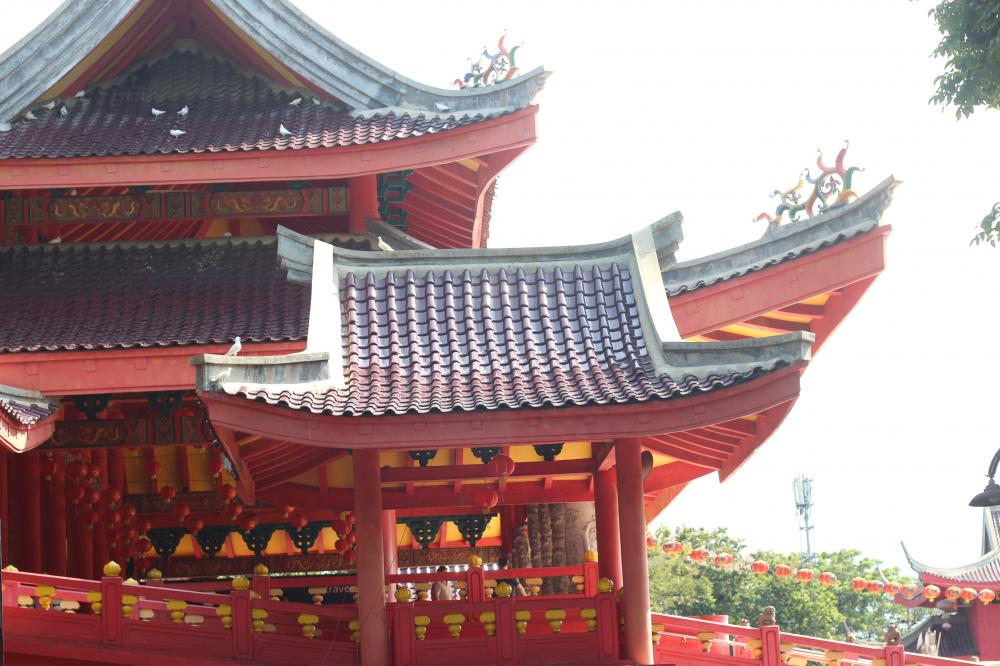Diving into the Story of Cheng Ho at Sam Poo Kong Temple, the Exploring Muslim Admiral from China

On Saturday, January 14, 2023, the Religious Studies Study Program conducted a study visit to various religious and cultural sites in Semarang, Central Java. One of them is Sam Poo Kong Temple which is located in West Semarang, Semarang City. This visit includes a tour around various buildings in the Sam Poo Kong area. Sam Poo Kong Temple is the oldest temple in Semarang with an area of 1,020 hectares.
Sam Poo Kong was founded by Thio Siong Thouw in 1965 and renovated in 2002 due to flooding problems that often occur around the temple. The renovation was completed in 2006 which coincided with the 600th anniversary of Cheng Ho's arrival in Semarang. The buildings in the temple include the Temple of the Earth God, the Tomb of Kyai Juru Mudi, the Temple of Sam Poo Tay Djien, the Tomb of Kyai Djangkar, the Temple of Kong Hu Cu and the Temple of Hoo Ping, Nyai Cundrik Bumi or the place where the Holy Dagger is kept and the tomb of Kyai Nyai Tumpeng.
The Sam Poo Kong Temple was founded as a tribute to Admiral Cheng Ho, an explorer who visited Semarang on his way to spread peace.
It is said that this temple was once the residence of Cheng Ho's crew members who settled in Java after Cheng Ho's journey in the archipelago. The building's distinctive East Asian architecture can be seen in the shape of the building with a three-tiered pagoda roof and dominating shades of red. Besides being influenced by Chinese architecture, the buildings in Sam Poo Kong also have a distinctive style of 14th century Javanese architecture.
While touring Sam Poo Kong, the session of seeing Cheng Ho's journey on the reliefs on the walls of the temple became one of the fun sessions. Seeing the journey of the Muslim Admiral from China to the archipelago and other regions. Cheng Ho's journey began with trade and peace efforts during the reign of Emperor Yong Le. Cheng Ho's journey in the archipelago saw him visit Java in 1406 and docked in Semarang when his helmsman became seriously ill in 1416. The helmsman, Wang Jing Hong rested while undergoing treatment.
Cheng Ho was born Me Ha in 1371 in Yunnan Province, the second son of Ma Hazhi and Wen. When his territory was occupied by Ming Dynasty troops while fighting Basalawarmi. His father was executed and young Cheng Ho was captured to be made an eunuch and serve Prince Zhu Di. It was also during this time that Cheng Ho was castrated. As a special servant of the Prince who would later become the emperor, he was appointed as a special servant of the prince.
His position as a servant of this country took him sailing to various parts of the world. Coupled with his brilliant achievements in the military, he easily earned the title of Admiral and coupled with his good posture. His expedition to sail around the world was sponsored by the Ming Dynasty government. The ship used in this voyage was known as the "Heritage Ship" which was the largest ship in the 15th century.
His background as a Muslim did not disappear after he was appointed as the leader of the expedition. As evidenced by the fact that before this voyage was carried out, Cheng Ho and other Muslim crew members performed the Fajr prayer at the mosque in Quanzhou City. His various expeditions to various parts of the world brought him to the archipelago. Cheng Ho's seventh expedition brought him to Nusantara. Coastal areas such as Samudera Pasai became Cheng Ho's first stopover as evidenced by the Cakra Donya Bell souvenir given to the Sultan of Aceh.
The next stop was at Muara Jati which is the territory of the sultanate of Cirebon. This long journey also led him to pull over on the coast of Simongan, Semarang because the helmsman was sick. While the helmsman, Wang Jing Hong was receiving treatment, Cheng Ho continued his voyage. Some of the crew members stayed in Semarang and married local people.
Cheng Ho's journey was not only limited to trade and friendship, but also carried a mission of peace. In addition to bringing this peace mission, Islam was also spread indirectly by Cheng Ho's crew members. The majority of the crew members were Muslims who spread Islam while leaning on the coast to trade. Even now, thanks to Cheng Ho's contribution to the archipelago, his name is immortalized as the name of many mosques in Indonesia.
Editorial Team of Study Program
Nurul Khorina Seci Vella
